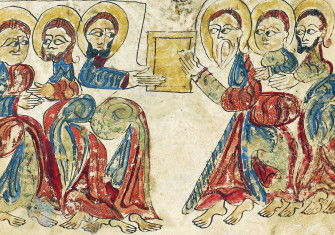Writ in Water
A kaleidoscopic tour of the Volga and the history of the people who have resided by it.

Europe’s longest river weaves through what has come to be seen as Russia’s heartland, from the Valdai Hills north-west of Moscow to its delta near Astrakhan where it empties into the Caspian Sea. The Volga also links numerous peoples, including Bashkirs, Mari, Tatars, Udmurts and Russians, all of whom live near its shores. Yet, though its length exceeds all other rivers in Europe, the Volga is still significantly shorter than several of Russia’s Siberian arteries and, though renowned regionally, the river nevertheless remains somewhat inconspicuous among the world’s ‘greatest’ rivers. It is certainly less thought about, spoken of or eulogised than the Nile, the Amazon, the Mississippi, the Yangtze or, perhaps, even the Danube.
Janet Hartley aims to correct the Volga’s marginalisation in her new book by putting it at the heart of a national history. Previously the author of a sweeping history of Siberia, Hartley proves an able guide on a kaleidoscopic tour of the Volga and the history of the people who have resided by it. From the earliest proto-states of the Jewish-led Khazars and the Islamic Bolgars to contemporary negotiations about the waterway’s status as a Russian river, Hartley treats the reader to captivating stories of conflict, conversion, trade, famine, migration and myth. Throughout, Hartley convincingly shows that any understanding of Russian history requires an understanding of the Volga.
For centuries, the Volga was used as a major conduit for trade and commerce, tying locations together economically that were already linked by water. The river’s utility for trade made it a confluence for divergent cultures, ethnicities and religions, which interacted with each other along its banks. Engagements among the diverse peoples of the Volga led to the formation of states and empires around it. Facilitated by the river, Muscovy’s conquest of the Khanate of Kazan in the 16th century was one of the most crucial early moments in determining the massive continental empire that Russia would become. As the country grew to incorporate the entirety of the river, it became increasingly tied to national identity. As Hartley writes: ‘Without the Volga, there would be no Russia.’
Beginning with the river’s earliest history, Hartley introduces readers to the populations that lived with the Volga before the emergence of Russian influence, including various Turkic groups in the south and the Mongol Empire in the 13th century. Under Ivan IV the emergent Russian state conquered the Volga towns of Kazan and Astrakhan, replacing mosques with Orthodox churches. The Volga became something of a frontier in the 17th and 18th centuries. Rebellions and uprisings among populations of peasants and Cossacks became common events, even as the river grew more integrated into trade networks. Hartley then turns to social life along the Volga and the river’s cultural significance in Russian identity, examining the experiences of villagers and townspeople, the river as a motif in Russian literature and the tumultuous changes of the late imperial era. Concluding with the Soviet era, the book meanders through the 20th century, paying particular attention to the Volga’s role in the momentous Battle of Stalingrad – today Volgograd – during the Second World War.
The book is a successful social history of Russia as told through its most famous river and is particularly informative about the many non-Russian ethnic groups who have lived with the river. Some topics, especially the Volga famine of the early 1920s, estimated to have killed five million people, might have been given more attention, but Hartley‘s long chronology perhaps makes certain omissions inevitable.
One thing the book is decidedly not, however, is an environmental history. The waterway is almost exclusively a backdrop for human societies and is barely seen as a natural object until a brief final chapter on the effects of Soviet canal building. The entire premise of decades worth of scholarship on environmental history – including a fair number of monographs on other rivers – is that it is insufficient to write human history with the rest of nature left out. Much of this book reads as a history of a river without water. Historians will have to wait for a biography of the Volga that takes the natural world seriously. That said, it is somewhat unfair to lament what a scholar did not do when their book is a powerful achievement. Hartley demonstrates that historians looking for narratives of Russia’s multi-ethnic past can start with the river that runs through it.
The Volga: A History of Russia’s Greatest River
Janet M. Hartley
Yale 400pp £25
Andy Bruno is the author of The Nature of Soviet Power: An Arctic Environmental History (Cambridge, 2016) and teaches at Northern Illinois University. He is also an affiliate of Tyumen State University, where his work is supported by a Russian Science Foundation grant (Project No 20-68-46044), ‘Imaginary Anthropocene: Environmental Knowledge Production and Transfers in Siberia in the 20th and 21st Centuries’.






